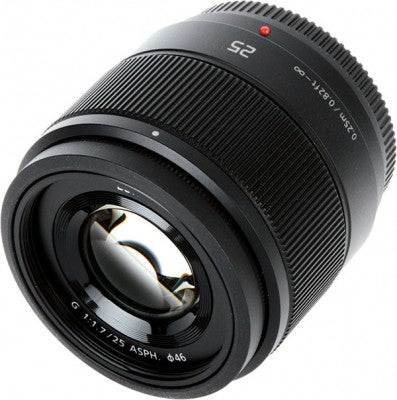Andy Westlake puts an inexpensive fast normal prime lens for Micro Four Thirds cameras to the test.
Panasonic Lumix G 25mm f/1.7 Asph review
Let’s first take a look at the alternatives that are already available. Panasonic itself makes the compact Lumix G 20mm f/1.7 II Asph and the faster Leica Summilux DG 25mm f/1.4, but they cost £270 and £380 respectively. Olympus has the M.Zuiko Digital 25mm f/1.8 that offers a near-identical core spec in a smaller size, but for around £290. Sigma makes 30mm f/2.8 and 19mm f/2.8 DN lenses that sell for a mere £130, but they gather 1.5 stops less light at maximum aperture. Finally, several ultra-fast manual-focus 25mm f/0.95 options are available from Voigtländer, Mitakon and SLR Magic, but at two or three times the price. Clearly, none of these gives quite the same combination of fast maximum aperture and low price.
This means that for budding photographers who’ve just bought into Micro Four Thirds, Panasonic’s new optic could well be the ideal second lens. Its fast maximum aperture allows use of faster shutter speeds or lower ISO sensitivities in low light, while also giving increased background blur when you wish to focus attention on a specific subject. It’s also small and light enough to carry around all the time. So let’s see if it lives up to expectations.
Panasonic Lumix G 25mm f/1.7 Asph – Features
Comprising eight elements in seven groups, the Panasonic 25mm has a more complex optical construction than most lenses with a similar angle of view. It also includes one ultra-high refractive index glass element and two aspherical elements, which are designed to minimise chromatic aberration and peripheral aberrations. The diaphragm comprises seven rounded blades, allowing the aperture to remain circular at larger f-numbers, which usually gives a more attractive quality to the background blur. It’s designed to be stepless and, like the focus motor, silent in operation, making the lens suitable for video use. However, there’s no optical image stabilisation on board.

Shot wide open at f/1.7, the 25mm lens can give some nicely blurred backgrounds
A broad manual-focus ring covers much of the barrel, and drives the lens’s focus group electronically. At the front is a thread that accepts 46mm filters, which don’t rotate on focusing. Behind it is a bayonet mount for the lens hood, which comes included in the box rather than being an overpriced extra. The lens is shipped with a cosmetic ring covering the hood mount, which I removed immediately and left in the box. Lens hoods don’t just shield the lens from stray light, but also protect the front element from accidental bumps, and I would encourage their use as a matter of course.





